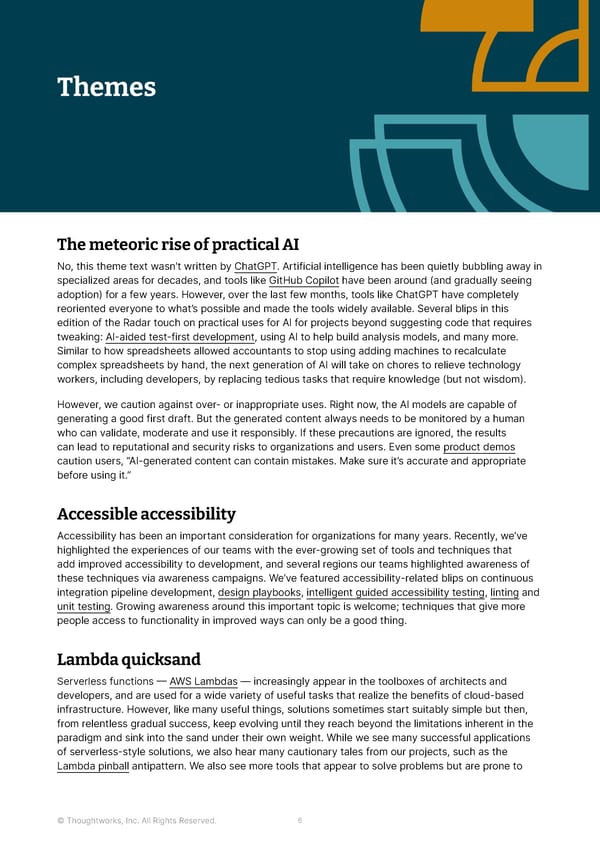Themes The meteoric rise of practical AI No, this theme text wasn’t written by ChatGPT. Artificial intelligence has been quietly bubbling away in specialized areas for decades, and tools like GitHub Copilot have been around (and gradually seeing adoption) for a few years. However, over the last few months, tools like ChatGPT have completely reoriented everyone to what’s possible and made the tools widely available. Several blips in this edition of the Radar touch on practical uses for AI for projects beyond suggesting code that requires tweaking: AI-aided test-first development, using AI to help build analysis models, and many more. Similar to how spreadsheets allowed accountants to stop using adding machines to recalculate complex spreadsheets by hand, the next generation of AI will take on chores to relieve technology workers, including developers, by replacing tedious tasks that require knowledge (but not wisdom). However, we caution against over- or inappropriate uses. Right now, the AI models are capable of generating a good first draft. But the generated content always needs to be monitored by a human who can validate, moderate and use it responsibly. If these precautions are ignored, the results can lead to reputational and security risks to organizations and users. Even some product demos caution users, “AI-generated content can contain mistakes. Make sure it’s accurate and appropriate before using it.” Accessible accessibility Accessibility has been an important consideration for organizations for many years. Recently, we’ve highlighted the experiences of our teams with the ever-growing set of tools and techniques that add improved accessibility to development, and several regions our teams highlighted awareness of these techniques via awareness campaigns. We’ve featured accessibility-related blips on continuous integration pipeline development, design playbooks, intelligent guided accessibility testing, linting and unit testing. Growing awareness around this important topic is welcome; techniques that give more people access to functionality in improved ways can only be a good thing. Lambda quicksand Serverless functions — AWS Lambdas — increasingly appear in the toolboxes of architects and developers, and are used for a wide variety of useful tasks that realize the benefits of cloud-based infrastructure. However, like many useful things, solutions sometimes start suitably simple but then, from relentless gradual success, keep evolving until they reach beyond the limitations inherent in the paradigm and sink into the sand under their own weight. While we see many successful applications of serverless-style solutions, we also hear many cautionary tales from our projects, such as the Lambda pinball antipattern. We also see more tools that appear to solve problems but are prone to © Thoughtworks, Inc. All Rights Reserved. 6
 Immersive Experience — Vol 28 | Thoughtworks Technology Radar Page 5 Page 7
Immersive Experience — Vol 28 | Thoughtworks Technology Radar Page 5 Page 7